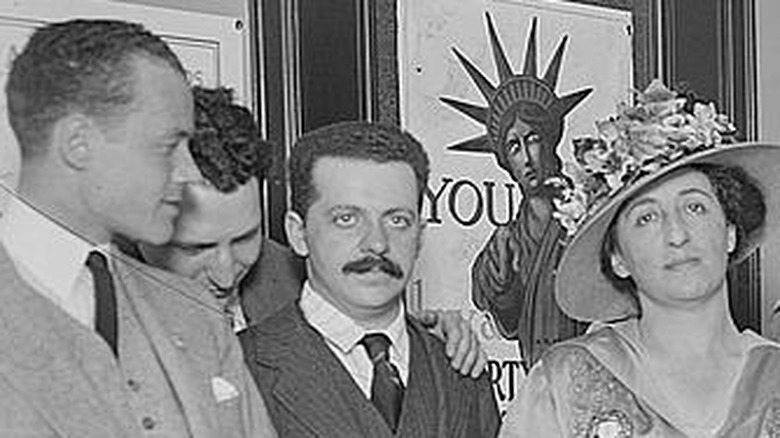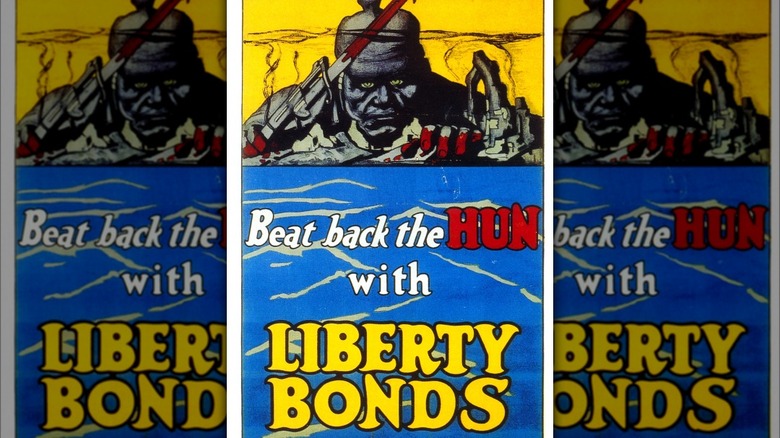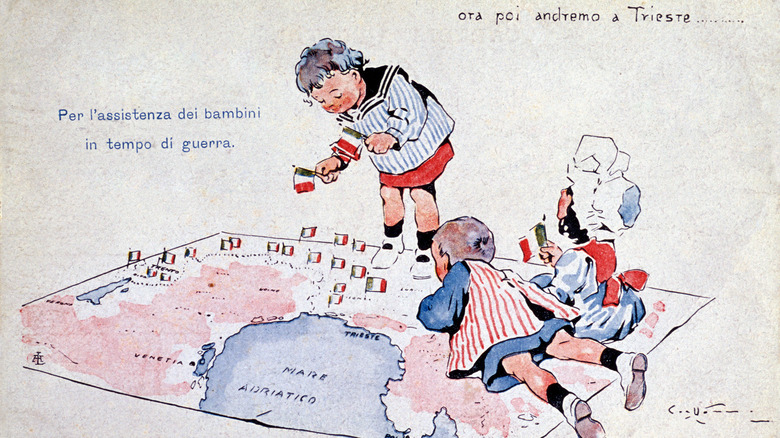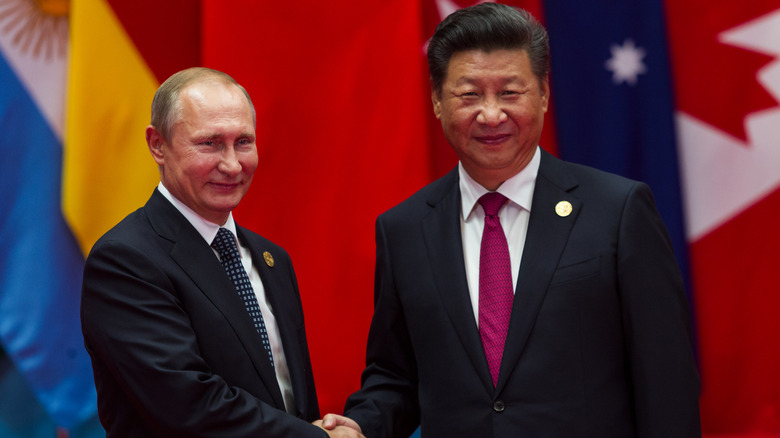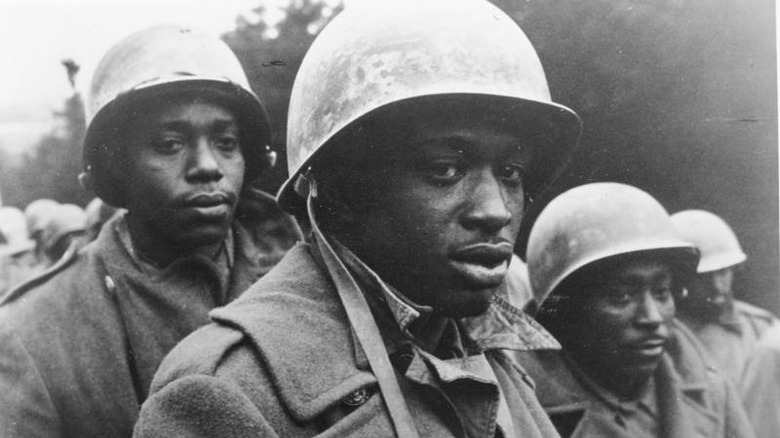This Is How War Propaganda Works
Propaganda. This word has gotten thrown around a lot lately, usually to refer to misinformation, disinformation, and lies in politics and war. Media outlets and countries accuse each other of running it regularly, and generally, the word has a negative connotation, which, according to Propaganda and Mass Persuasion, is due to its negative use in Nazi Germany and the Soviet Union to justify the murders of millions. But the reality is that propaganda is broadcast all the time whether in the news, on social media, or through politicians, activists, or bodies.
So how does propaganda, especially in war, work? As Edward Bernays argued in his book "Propaganda," war propaganda is really no different than business propaganda (aka advertising). It is all about manipulating symbols, word associations, and images to produce a desired reaction on a mass scale. Here are some examples of how war propaganda has been — and continues to be — used to manipulate public opinion into supporting or opposing conflicts and warring parties.
What is propaganda?
Before giving examples of war propaganda at work, it is necessary to define the term, which is unfortunately misused. Edward Bernays (above, second from right), known as the "father of prublic relations," noted in his book, "Propaganda," that propaganda is simply "an organized effort to spread a belief or doctrine," or put another way, the method for manipulating public opinion. It is literally everywhere, from slogans, to editorials and magazines, advertising, and, of course, war. Its use for nefarious purposes in war is what has given the word its negative connotations today.
Because of its negative connotations, propaganda is often thought of as lies or falsehoods in order to advance an evil cause. But Bernays argued that propaganda can be good. It just depends on what the cause is. It can also be true — but with a spin. In practice, as "Propaganda and Mass Persuasion" notes, propaganda can range from blatant lies all the way up to the truth. In fact, the best propaganda often will try to tell the truth, or at least get as close to it as possible. The closer to the truth the more believable it is. Ultimately, it aims, as Bernays noted, to produce an impulsive emotional reaction among masses of people.
Tugging at the heartstrings
In order to involve itself in a conflict, a government must have the support of at least some of its public, which will bear at least the financial cost of the fighting, if not the bulk of the human cost too. Thus, the public must be swayed into fighting through various techniques, all of which involve some sort of emotional manipulation. Among the most effective is the tactic termed "tugging at the heartstrings."
Such propaganda manipulates viewers with images and stories of brutalized civilians — women and children in particular. President Bill Clinton's 1995 Bosnia speech (via CNN) did precisely this, pitching American intervention as a humanitarian endeavor to prevent further "Bosnian Serb shelling [that] once again turned Bosnia's playgrounds and marketplaces into killing fields." The president's speechwriter chose these words carefully, as both locations are where society's most vulnerable — children — tend to congregate.
President Clinton's 1995 address was more subtle, especially when compared to the masterpiece of naked propaganda Americans were subjected to in 1990. That year, an 15-year old Kuwaiti girl named Nayirah addressed the U.S. Congress, claiming that invading Iraqi forces had thrown Kuwaiti babies out of incubators and killed them. But as Democracy Now! reported, it was unadulterated propaganda, though it had a core of truth — otherwise no one would have bought it. Children had died in hospitals because Kuwaiti hospital workers had fled. But Congress fell for the false testimony, which was broadcast all over the country, and voted to launch Desert Storm soon after. After all, who wanted to be held responsible for dead infants?
Stereotyping, othering, and dehumanization
Time Magazine notes that killing other human beings, especially random foreigners that one has never met before, is not easy. In the study cited, it was noted that test subjects often humanized their victims, making it likely that an ordinary combatant who is not already hardened into a killer will be incapable of simply killing opponents. Unsurprisingly, this type of propaganda is, per Al Jazeera, is one of the 10 stages of genocide.
This is where the dehumanization propaganda enters. As the Journal of Human Rights and Conflict Resolution (via HSC) notes in a discussion of the Rwandan Genocide, the dehumanization narrative is a two-pronged strategy. It creates an "us vs. them" narrative to break society into two distinct camps. Propaganda then presents an opponent as something less than human, making it a little easier to kill them.
The propaganda of the world wars relied heavily on this type of messaging. In the United States, Americans were called to "beat back the Hun" (aka Germans), who, per Southern Adventist, were portrayed as animalistic barbarians akin to the Huns that devastated the Roman Empire in the fifth century A.D. Therefore, Americans should purchase liberty bonds to help stop the German terror in Europe, or even better, sign up to go fight in Europe. Under the Nazis, Germany did the same to its Jewish population. As the Philadelphia Holocaust Museum notes, Jews were portrayed as sucking at a pig's teat, or were likened to serpents or rats. Unsurprisingly, this type of propaganda, per Al Jazeera, has usually preceded the worst crimes against humanity in the form of genocide.
Historical revisionism and irredentism
This type of propaganda plays on real concerns about the status of one's co-ethnics who are caught on the wrong side of a national border. It often plays on the desire of irredentism, which, per Britannica, is the idea that a nation must incorporate its nationals that fall under neighboring states into its own borders — by force if necessary.
In such a situation, a country will use the issue of its people in other states to influence its population to war in defense of their co-ethnics. Italy, the creator of the term "irredentism," justified its entrance into World War I with this logic. According to scholar Cristina Gragnani, Italian populations in Istria and Dalmatia had been the victims of Slavic (particularly Croatian and Slovenian) aggression with Austro-Hungarian backing. These forces together were conspiring to Slavicize, so Italy had to protect them.
The obvious problem with irredentist propaganda is that it only depicts one side of the story. Although Slavic and Austrian irredentists were attempting to eradicate Italian culture, Italy did the same to Istrian Slavs under Benito Mussolini. Thus, irredentism must be combined with dehumanization, since a population needs to be convinced that killing fellow humans will produce some greater good. Unsurprisingly, the whole situation, per Balkan Insight, ended badly when World War II broke out. The Italians of Istria and Dalmatia were killed or expelled from lands they had inhabited since Roman times while thousands of Slavs perished under Italo-German occupation.
Fear, uncertainty, and doubt
A piece published by the British Psychological Society confirms what many people have known for some time: Humans like stability and will often go to great lengths to maintain it. But fear of instability, uncertainty, and doubt regarding the future can be used to turn public opinion in favor or against a conflict. The logic is fairly simple. In the former scenario, a party will sell a war by playing on public fears of the possible ramifications of not fighting, a tactic the Bush Administration executed in 2003.
As the debate over a possible American invasion of Iraq raged, the Brookings Institute notes that the Bush Administration and the American media broadcast what effectively amounted to propaganda linking Saddam Hussein to terrorism, weapons of mass destruction, and 9/11. When these were not sufficient, the media and the administration doubled down. In 2003, CNN carried a piece that quoted secretary of state Condoleezza Rice (above) as saying that America "knows that he [Saddam] has the infrastructure, nuclear scientists to make a nuclear weapon." However, there was no "smoking gun." So Rice argued that there was no time to find one because she did not "want the smoking gun to be a mushroom cloud." The underlying message was clear. If the United States did not invade Iraq, Saddam would nuke the United States in something far worse than 9/11. This was a lie, but per Gallup, it worked, as approximately 70% of Americans initially supported removing Saddam by force.
Virtue signaling
This one is probably familiar to Americans as well, as it has been the major selling point for most U.S. wars since Desert Storm. This type of propaganda is a form of emotional manipulation that turns public opinion in favor of conflict by casting a party's cause as humanitarian. In practical terms, a conflict is sold as defending "democracy," "liberty," or "human rights" in places that are under "fascists," "Nazis," or dictators.
Writing for UCLA, Douglass Kellner picked apart this aspect of the Bush Administration's propaganda to sell the Iraq War — and for that matter, the Global War on Terror. Thus, the Iraq War became a war of the liberation (aka Operation Iraqi Freedom) to bring democracy and freedom to a country that was suffering under a rogue dictator. When support for U.S. Middle Eastern adventures declined, President George Bush (above), per CNN, termed American involvement as part of the fight of democracy against "Islamic fascists."
This term in itself is meaningless and demonstrates a lack of understanding of fascism's actual definition – the merger of corporate and state power. But that is irrelevant because the propaganda lies in word association. Fascism is associated with dictators such as Hitler and the Holocaust, while Islam is associated with terrorism. Thus, fascism is the opposite of American democracy while Islam is an ideology that wants to overthrow America. This produces the "with us or against us" effect, in which anyone that opposes the war must hate freedom and democracy because he supports "Islamo-fascism."
Whataboutism
Through propaganda, parties attempt to portray themselves as righteous in conflicts. But what if a party is guilty of the same things it criticizes its opponents? One option is projection, accusing an opponent of that which one is guilty of. The other, more common tactic is the "Tu Quoque." As professor Richard Nordquist explains (via ThoughtCo), it translates literally as "you too." So if one person accuses another one of cheating, the accused will note that the accuser is also guilty. In propaganda, it is known as "whataboutism," wherein one actor will respond with a similar accusation when accused of an offense (aka "what about what you did, too?").
Recent events have pushed the "whataboutism" front and center. When diplomat Victoria Nuland (via former Intercept journalist Glenn Greenwald) accidentally admitted the existence of American biolabs in Ukraine before Congress, Russia and China, per the Atlantic, seized upon their existence to discredit the United States and justify their own positions vis-à-vis Ukraine. But as CNN noted, Russia has its own biolabs labs in Siberia (and one of the few remaining smallpox samples), while China hosts the Wuhan Institute of Virology, a facility that, per the NY Post, engaged in illegal gain-of-function research with bat coronaviruses.
As one can see, all three parties are guilty of contravening the UN Biological Weapons Treaty of 1972. So to avoid being called up on the international stage, countries must redirect public and international criticism against their geopolitical rivals. Russia, the United States, and China have all done this, basically saying, "What about your biolabs?" when trading accusations. Hence the name "whataboutism."
Beautiful people
How can a country convince people to support its wars? In particular its young men? Countries often take a page out of the advertising world, which uses sexual desire by associating products with beautiful, dignified, or scantily-clad women. This type of war propaganda, yet another form of emotional manipulation, is usually directed at men to sway their opinions in favor of war or military service.
This tactic has been common throughout wars and is clear in World War I propaganda posters from Britain's National Army Museum. One poster — called "Women of Britain say 'Go!'" — shows two elegantly-dressed women and a child urging British men to sign up, implying that it is their duty to defend the women from foreign aggressors. A similar poster promotes the same message, but swaps out the younger women with an elderly lady.
Lately, this tactic has resurfaced with the proliferation of social media. According to the NY Post, the Israeli army has flooded social media with sexy pictures of their most attractive female soldiers, popularly called "thirst traps." The Post notes that this is effectively a propaganda campaign to convince Israel's opponents to drop their opposition to Israeli-involved conflicts in the Middle East. It probably doesn't hurt recruitment efforts among diaspora Jews either though. Ukraine has done the same, posting pictures of a former Miss Ukraine (via the Express) holding a gun captioned with patriotic messages, presumably to try and galvanize international support for its conflict with Russia.
Appeal to manhood
This one is similar to the method of using "beautiful people" but usually involves men instead of women. According to SUNY Geneseo, this type of propaganda is used to convince men to volunteer for wars by appealing to their manhood and toughness — often (but not always) with the underlying message that anyone who does not is not a real man.
The direct appeal to masculinity, originally conveyed in posters such as this Italian example, which depicts a tough-looking soldier urging recruits to join the SS divisions, can now be conveyed much more effectively through video. This is best exemplified in the viral Russian Army recruitment video. Showing well-muscled Russian soldiers performing feats of physical strength in training, parachuting out of planes, or fighting in snow, it invites Russian men, regardless of their pasts, to improve themselves while serving their country. In other words, if a young Russian man wants to be like the men in the video (aka the best form of himself), he should join the army.
A variant of this type of propaganda indirectly appeals to manhood through women. A WWI Irish poster (via SUNY Geneseo), pressures Ireland's women to shame their husbands into enlisting to fight the Germans in Europe. It is a man's duty to defend the defenseless women and children that are being slaughtered on the front lines, and no woman — goes the poster — wants to be judged for having a husband or son that did not do his part. The underlying message, though, is the same. Any opponents of the war are cowards undeserving of their women.
Division and demoralization
Propaganda is not only for internal consumption; it can be tailored against opponents too. In the past, this was done with the dropping of leaflets, although the internet has allowed the use of social media for such purposes, too. A party to a conflict may use this tactic to sow division in enemy ranks, turn a rival's public opinion against war, or undermine the morale of front-line soldiers.
African-American soldiers (above) in World War II were subject to an intense German propaganda campaign. According to the US Holocaust Memorial Museum, German propaganda leaflets highlighted the inequalities of segregation in the Jim Crow South, where African-Americans were barred from churches, restaurants, and other public facilities. Meanwhile, Hitler's Germany argued that since there was no institutional discrimination against "Colored people" in Germany, these African-American troops would be better off fighting for Germany. Thus, the leaflet called on them to desert and fight alongside the Germans, who would treat them better.
Sometimes, however, such propaganda could backfire. According to the website for the documentary "Fire and Ice," Soviet forces conducted an intense propaganda campaign against Finland in 1939, bombing Finnish cities with bombs and leaflets urging Finland to surrender to their new, supposed liberators. The propaganda turned out to be completely useless, as Finland proceeded to fight harder in defense of its independence. But Finnish propaganda failed, too — it was often too high-blown for the average illiterate Red Army soldier.
Flag waving
This one is a variant of virtue signaling that, according to the University of Salisbury, involves playing on people's sense of duty to the country or nation they are a part of. Put differently, it calls for people to make sacrifices — sometimes with their lives -– for the "greater good." This type of propaganda was commonly combined with the "beautiful people" type of propaganda to produce the patriotic flag-waving posters of the world wars that depicted countries and patriotism as pure, unsullied women (such as the Finnish example above) that must be defended from foreign aggressors. The Atlantic hosts an excellent example, in which America (aka Lady Columbia) is portrayed waving an American flag and holding a sword while calling on America's young men to enlist in defense of American civilization. Here, the parallel to the "beautiful people" is clear. American men must defend the beautiful Lady Columbia (the personification of the U.S.). As usual, the underlying message is that anyone that does no enlist is unpatriotic.
The idea behind these flag waving posters is to prevent the kind of situation portrayed in a World War I propaganda poster from the Smithsonian. Here, a gorilla personifying Germany carries a defiled, bare-breasted woman while trampling on America. Presumably, the woman is a personification of an America defiled and destroyed by a German invasion. It is the responsibility of America's young men to ensure that this scenario does not occur. And as mentioned earlier, a country and its flag personified as a beautiful woman is a much more effective recruitment tool than just a flag.
Show of force
Sometimes, the best way to defeat an opponent is not to fight him at all by cowing him with a show of force. This can be done physically, perhaps by massing soldiers on the border, but it can also be done with propaganda videos that showcase a country's military hardware and toughness. Basically, the video sends out the message of "don't mess with us or else."
The best recent example comes from a Chinese People's Liberation Army recruitment video, "We will always be here." The video includes the standard flag waving, but unlike its Russian counterpart, which showcases the soldiers' physical strength and is clearly aimed at recruitment, the Chinese video appears more oriented to showcasing China's military hardware. It stresses the "innovations and reforms," while showcasing China's military hardware that has catapulted the country to global power status.
The message is obvious. China is not a country to be trifled with militarily. But occasionally, such propaganda can go wrong if it is unmasked as fake. This Chinese propaganda video for the air force, for instance, shows China's "Gods of War" bombers attacking the U.S. island of Guam. But as the Guardian noted, several of the scenes came from Hollywood movies, which raises the obvious question: What else is a lie?

